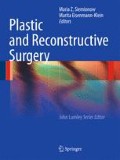Summary
Wound Healing is a complex and tightly regulated process involving different cell types and a large number of growth factors and cytokines which have their specific roles in the wound healing phases which are referred to as inflam-mation, proliferation and regeneration. Dysre-gu lation of the physiologic wound healing process may lead to disturbed wound healing such as scar formation or delayed healing. The aim of current wound therapy is to optimize conditions for the healing process and provide custom-tailored individual treatment for different wound healing problems by the use of adjunct therapies as well as innovative therapeutic strategies.
Access this chapter
Tax calculation will be finalised at checkout
Purchases are for personal use only
Abbreviations
- bFGF:
-
Basic fibroblast growth factor
- GM-CSF:
-
Granulocyte monocyte colony stimulating factor
- IFNγ:
-
Interferon-gamma
- IL:
-
Interleukin
- MMP:
-
Matrix metalloproteinase
- PDGF:
-
Platelet-derived growth factor
- PF:
-
Platelet factor
- TGF:
-
Transforming growth factor
- TNF:
-
Tumor necrosis factor
- tPA:
-
Tissue-type plasminogen activator
- uPA:
-
Urokinase-type plasminogen activator
- VEGF:
-
Vascular endothelial growth factor
References
Allen DB, Maguire JJ, Mahdavian M, et al. Wound hypoxia and acidosis limit neutrophil bacterial killing mechanisms. Arch Surg. 1997;132:991–996.
Argenta LC, Morykwas MJ. Vacuum-assisted closure: a new method for wound control and treatment: clinical experience. Ann Plast Surg. 1997;38:563–576.
Berger A, Hierner R. Plastische Chirurgie. Grundlagen, Prinzipien, Techniken. 1st ed. Berlin: Springer; 2003.
Blackburn WR, Cosman B. Histologic basis of keloid and hypertrophic scar differentiation: Clinicopathologic correlation. Arch Pathol. 1966;82:65–71.
Broughton G, Janis JE, Attinger C. Wound healing: an overview. Plast Reconstr Surg. 2006;117:1e–S.
Bucalo B, Eaglstein WH, Falanga V. Inhibition of cell proliferation by chronic wound fluid. Wound Repair Regen. 1993;1:181–186.
Diegelmann R. Analysis of collagen synthesis. Methods Mol Med. 2003;78:349–358.
Falanga V, Sabolinski M. A bilayered living skin construct (Apligraf) accelerates complete closure of hard-to-heal venous ulcers. Wound Repair Regen. 7:201–207.
He Z, King GL. Microvascular complications of diabetes. Endocrinol Metab Clin North Am. 2004;33:215–238.
Horch RE, Kopp J, Kneser U, et al. Tissue engineering of cultured skin substitutes. J Cell Mol Med. 2005;9:592–608.
Kloth LC. 5 questions-and answers-about negative pressure wound therapy. Adv Skin Wound Care. 2002;15:226–229.
Kurkinen M, Vaheri A, Roberts P, et al. Sequential appearance of fibronectin and collagen in experimental granulation tissue. Lab Invest. 1980;43:47–51.
Longaker MT, Adzick NS, Hall J, et al. Studies in fetal wound healing: VII. Fetal wound healing may be modulated by hyaluronic acid stimulating activity in amnionic fluid. J Pediatr Surg. 1990;25:430–433.
Martin P. Wound Healing-aiming for perfect skin regeneration. Science. 1997;276:75–81.
Massberg S, Messmer K. The nature of ischemia/reperfu-sion injury. Transplant Proc. 1998;30:4217–4223.
Mulligan RC. The basic science of gene therapy. Science. 1993;260:926–932.
Niessen FB, Spauwen PH, Schalkwijk J, et al. On the nature of hypertrophic scars and keloids: a review. Plast Reconstr Surg. 1999;104:1435–1458.
Petrie NC, Yao F, Eriksson E. Gene therapy in wound healing. Surg Clin North Am. 2003;83:597–616.
Sabiston D. Textbook of Surgery: The Biological Basis of Modern Surgical Practice. 15th ed. St Louis, MO: Saunders; 1997.
Steinbrech DS, Longaker MT, Mehrara B, et al. Fibroblast response to hypoxia: the relationship between angiogen-esis and matrix regulation. J Surg Res. 1999;84:127–133.
Witte M, Barbul A. Role of nitric oxide in wound repair. Am J Surg. 2002;183:406.
Author information
Authors and Affiliations
Editor information
Editors and Affiliations
Rights and permissions
Copyright information
© 2010 Springer-Verlag London Limited
About this chapter
Cite this chapter
Horch, R.E., Bleiziffer, O., Kneser, U. (2010). Physiology and Wound Healing. In: Siemionow, M.Z., Eisenmann-Klein, M. (eds) Plastic and Reconstructive Surgery. Springer Specialist Surgery Series. Springer, London. https://doi.org/10.1007/978-1-84882-513-0_1
Download citation
DOI: https://doi.org/10.1007/978-1-84882-513-0_1
Publisher Name: Springer, London
Print ISBN: 978-1-84882-512-3
Online ISBN: 978-1-84882-513-0
eBook Packages: MedicineMedicine (R0)

